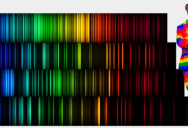Indiana University Professor Has Turned Every Element Into A Unique Sound So You Can Make Music Based On The Periodic Table Of Elements

Most people are familiar with the periodic table of elements from basic high school science classes. This table lists all of the known elements of the universe, the atomic number and mass of each one, and more.
What this table does not tell you, is what each element sounds like.
Thinking about what an element sounds like seems a little odd, after all very few people have held up a titanium ring, for example, and listened to it. W. Walker Smith of the University of Indiana, however, has applied a method that has been used to assign sounds to elements and done it for the entire periodic table of elements.
This is possible because when an element is energized, the electrons in it jump to higher energy levels. As the energy dissipates, those electrons return to their original state while releasing a photon.
The photon that is released has a specific wavelength that is based on the energy gap between the ground state and the excited state of the element.

The more energy present, the higher the frequency of the light from the photon.
This is one of the processes that is used to help us identify elements in distant stars. Scientists can measure the wavelengths of the light that is emitted, measure, and determine the element within the star through a process known as emission spectra.
Each element’s electromagnetic spectrum can then be converted to sound.
This has been done in the past, attempting to play the sound of elements on a piano. The problem is that the piano does not have enough notes to capture the differences between notes.
In addition to creating musical notes, he also generated visible light for each element based on the same information. He had to multiply the frequencies by 10-12 in order to convert it to light that humans can see.
In order to accomplish this, he worked with Professor David Clemmer of the chemistry department and Professor Chi Wang of the music department at Indiana University to ensure he got everything right.
Smith is taking this project and has turned it into an exhibit at the WonderLab Museum, located in Bloomington, Indiana. He says of this project:
“I want to create an interactive, real-time musical periodic table, which allows both children and adults to select an element and see a display of its visible light spectrum and hear it at the same time.”
You can see (and hear) this in action by watching the video below.
Who knew we could listen to the elements that make up the universe.
If you thought that was interesting, you might like to read a story that reveals Earth’s priciest precious metal isn’t gold or platinum and costs over $10,000 an ounce!

Sign up to get our BEST stories of the week straight to your inbox.




